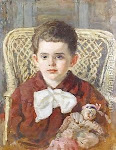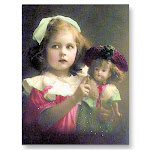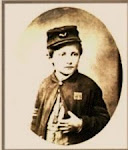
Schnickle-Fritz and Harlequin Clown from Diane Dustir collection
Albert Schoenhut, was the creator of marvelous toy pianos, intricate circus figures and lifelike dolls who were said to be modeled on his grandchildren’s likeness. Born in Germany to a family with a legacy of doll making since the 1700s, and who at seventeen, was one of the many German-born immigrants who settled in Philadelphia during the second half of the 19th century. This was a time of an ever growing and thriving German community that helped each other, and celebrated their heritage. Albert was employed at the Wanamaker's department store, repairing the broken glass sounding pieces in German toy pianos (also known as the kinderklavier (child's keyboard) that were damaged during shipping. Around this time he met and married Philadelphia born Emilie Langbien. A year late, their first of nine children, Albert Frederick was born.

From my own collection; Schoenhut Piano and at the keyboard...my 29" Karl Hartman girl.
While working at Wanamaker’s he conceived the idea of the toy piano as we know it today. He replaced traditional fragile glass bars, with durable steel plates that were strucked by hammers, and added spacers to hold the bars in place, this made the keys very difficult to dislodge during play. Finally in 1872 Schoenhut began producing his own toy pianos.

Stick Horse... Diane Dustir collection


Circus with animals and figures courtesy of Jim Sneed
At this time the young family moved to a one room flat in the Kensington section of Philadelphia where he was assisted in his work by his wife. It was here we glimpse the extent of his creative genius. For years, they handcrafted only wooden musical toys, carts and animals. In 1902 Schoenhut was approached by inventor Fritz Meinecke, who had mastered a way of holding the animal’s different parts with elastic, thus giving the toy movement and endless hours of play by the different poses it could achieve. Schoenhut bought the patent for the animal design and it became the basis of “The Humpty Dumpty Circus” which became a favorite of the company until its end in 1935.

Roly Clown... Jim Sneed collection
One of the first doll- like figures, “The Rolly Dolly” first appeared on 1908. They were manufactured from a composition material with weights imbedded in their bottoms so they would right themselves in a rolling motion when tipped over. They were a success story proving to be a sturdier version of a particularly old toy.

Graziano designed dolls
In 1911, he opened his doll manufacturing business, using mostly basswood for their bodies. After the dolls were carved, they were placed into molds that were fitted with pressure and high heat creating a smooth texture, and eliminating rough edges. This process resulted in an almost bisque look on his dolls. He still used the traditional jointed arms and legs, but he did not use rubber cord to hold it together; Instead, he patented his invention of steel spring hinge tension to hold up the dolls' joints. This method gave the flexibility and durability needed for the dolls to be posed in numerous ways, providing many hours of creative play for children. Finally the whole doll was given several coats of oil paint, which did not come off when washed by a small owner. The first few dolls that were manufactured measured 16 inches tall and the head was designed by an Italian sculptor and artist named Graziano,: These were four girls and four boys with carved hair, eight girls,and four boys with wigs and two infants. These dolls appeared to have very thin paint and no gesso underneath thus the paint wore off easily with repeated washings.


Then in 1912 Albert’s brother, Harry Schoenhut, was hired as the lead artist who designed the new series of dolls using better paints that would withstand both play and cleaning. The most dramatic change, however, was that the new dolls appeared to have much younger faces, while the Graziano dolls represented children from eight to twelve years of age.

16/102 Original handmade clothing, factory leather shoes


The late Albert Schoenhut, founder of The A. Schoenhut Co., established 1872, incorporated 1897
The classic period of Schoenhut dolls began in 1912, sadly the same year Albert Schoenhut died in his sleep leaving his son Albert Frederick in charge during the most glorious years of the company when the dolls faces were at their most prolific and the greatest variety.

From my collection a 19/308 as it came to me originally.

Doll 19/308 (on the right) after I had her hair redone, and re-dressed from a Schoenhut pattern

16/300 original homemade nurse’s uniform

16/106 Bonnet Head

14/102 girl & 14/207 boy, girl’s dress copy of Schoenhut style, boy’s suit original handmade
Schoenhut dolls are easily identified by size number (first), series or face number next. This method of recognizing started with the Graziano period. For example: doll # 19/105, is a 19” carved hair doll.
The 100 series consists of the carved hair girls; the 200 series were carved hair boys; the 300 series were wigged girls (with some of the most beautiful character faces); and the 400 series were wigged boys:

The # 316…Also known as “Miss Dolly”...
Who Can Do Almost Anything But Talk... Finally!
A sweet dolly, for little girls to dress in ruffles and lace. Not unlike those other German bisque dolls with the short upturned nose, and the open-mouthed look. She has smooth eyes painted blue or brown and varnished to give her the glass eye look of German dolls. Later this was replaced by decal eyes, giving it a more realistic look. Miss Dolly is the most recognizable of the Schoenhut dolls and the original was produced until 1924.

Schnickel-Fritz
In 1911, the company expanded and came up with an infant doll series with curved wooden arms and either mohair or molded hair. These were distributed all over United States and in catalogs. The famous two 15-inch infant dolls with molded hairstyle were named Tootsie Wootsie, an infant with fat cheeks and wide opened eyes; and the other was Schnickel-Fritz, an older child with a mischievous grin. Although the company called them infants, these two were not really infants, they were designed more like toddlers, and were fully jointed.

From my collection "Nature Baby"

From Don Barnes collection: Nature Baby and Miss Dolly
The Baby dolls, and Nature Babies series, were #107 through #110. Some with painted hair, others were wigged. These appeared to be designed by Albert’s son Harry Schoenhut. Doll number 107 was also designed on a bent limb body described in catalogues as having “Nature’s Arms and Leg” Doll # 108 was also designed in both jointed and Nature Limb bodies, but in a much larger doll.

The company also created mannequins for garment merchandising, and for clothing studios, it came in the 19” size only, and was manufactured from 1914 to 1918. Originally presented as A Manikin for Students Of Fine Art, or Dressed Figures for Window Display, and it was given the number/series 19/175.
This doll was designed to look as a young man and it included three sports figures: a Basket Ball player, a Foot Ball player, and Base Ball player. The “Manikin” has a very interesting face, and it’s indeed a treat to find one.

Hundreds of toys, doll houses and dolls followed: Mama dolls with stuffed bodies and a voice box, infants with movable eyes, even a Schoenhut version of Gracie Putnam’s Bye-Lo Baby. Yet around the time of the Great Depression, the company's sales began to dwindle; partly due the popularity of electric action toys, and power trains. Dolls were imported by the droves from Germany, where labor was cheap, so they were being sold at half the cost of an American manufactured doll. At the same time newer dolls came in with lighter and better materials, children seemed to like these cuddlier dolls better than the heavier wooden ones. However in the late 1924, the company produced a kind of stuffed dolls that were made with a hollow wooden head but it was of an inferior kind and costumers did not take to them. The dolls did not sell, and all but gather dust in the shelves. By the year 1935, the company was then liquidated since they were not able to keep up with competitors who were mostly into bisque and vinyl doll-making.

From my collection
I am the proud owner of a handful of Schoenhuts. They all have bruises, dings; a chip here or there. Lucky for me they survived the “rough” love of those children from yesterday. But there is something in those faces so realistic; like they want to speak and tell me stories. I love these dolls with their bruises and pensive faces...
…if only.
Bibliography:
My deepest thanks to Jim Sneed from "All About Old Toys" for allowing me to use the amazing photographs from his collection, and the collection of Diane Dustir. All the doll photos unless otherwise noted are from the collection of Diane Dustir.
Also thanks to my friend Don Barnes for his pictures of Miss Dolly and Nature Baby.

 I am very excited to announce that I have been selected to be part of the cast of “It’s a Wonderful Life”. This has been a favorite movie of mine and I am sure for many of you as well… The play is full of wonderful Christmas music and a lovely story.
I am very excited to announce that I have been selected to be part of the cast of “It’s a Wonderful Life”. This has been a favorite movie of mine and I am sure for many of you as well… The play is full of wonderful Christmas music and a lovely story. It's a Wonderful Life is a 1946 American Christmas drama film... This was director Frank Capra's classic bittersweet comedy/drama about George Bailey, the eternally-in-debt guiding force of a bank in the typical American small town of Bedford Falls. A man whose imminent suicide on Christmas Eve brings about the intervention of his guardian angel, Clarence Odbody (Clarence shows George all the lives he has touched and the contributions he has made to his community.
It's a Wonderful Life is a 1946 American Christmas drama film... This was director Frank Capra's classic bittersweet comedy/drama about George Bailey, the eternally-in-debt guiding force of a bank in the typical American small town of Bedford Falls. A man whose imminent suicide on Christmas Eve brings about the intervention of his guardian angel, Clarence Odbody (Clarence shows George all the lives he has touched and the contributions he has made to his community. George declares that he wishes that he had never been born, and Clarence, hoping to teach George a lesson, shows him how different life would have been had he in fact never been born. After a nightmarish odyssey through a George Bailey-less Bedford Falls (now a glorified slum called Potterville), wherein none of his friends or family recognize him, George is made to realize how many lives he has touched, and helped, through his existence; and, just as Clarence had planned, George awakens to the fact that, despite all its deprivations, he has truly had a wonderful life.
George declares that he wishes that he had never been born, and Clarence, hoping to teach George a lesson, shows him how different life would have been had he in fact never been born. After a nightmarish odyssey through a George Bailey-less Bedford Falls (now a glorified slum called Potterville), wherein none of his friends or family recognize him, George is made to realize how many lives he has touched, and helped, through his existence; and, just as Clarence had planned, George awakens to the fact that, despite all its deprivations, he has truly had a wonderful life.

















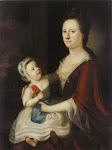

























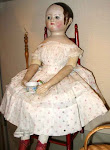.jpg)









































